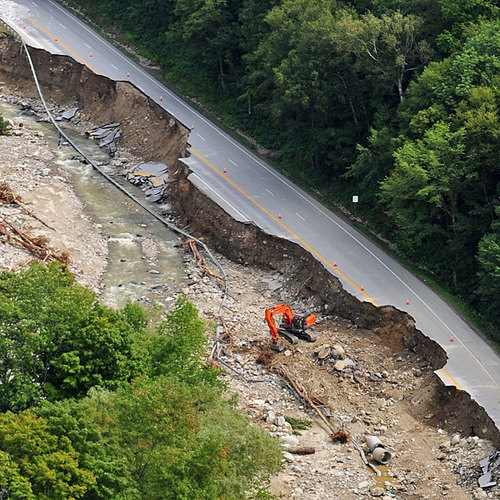
Billions of dollars in much-needed federal funding are finally being made available to nine states and five local communities. These dollars are to be used for activities and projects that reduce vulnerability to future disasters, including consideration of how such disasters could become more dangerous due to climate change.
The federal Department of Housing and Urban Development (HUD), the agency overseeing these grants, is making it clear that these dollars are not the typical federal disaster aid, which tends to put everything back in the same vulnerable locations and replicate vulnerabilities that were just made evident in a disaster. These dollars will require grantees to design projects with an additional margin of safety for flooding, to factor in projected future sea level rise, and to invest much more heavily in forward thinking measure that reduce the risk of future damages in the face of climate change.
The $6.875 billion now being made available by HUD will be going to nine states and five local jurisdictions that previously received congressionally approved Community Development Block Grant-Disaster Recovery (CDBG-DR) funds between 2015 and 2017. An additional $9.059 billion for Puerto Rico and the U.S. Virgin Islands will be made available separately.
Wait a minute, HUD is a federal agency. The Trump administration is funding work to address the impacts of climate change?
Essentially, yes, whether the president knows it or not.
While the words “climate change” never actually appear in HUD’s description of the grant program, there are multiple references in the document to changing future conditions, which can only occur as a result of climate change. Examples of such language include:
- “…the action plan must include a risk-based Mitigation Needs Assessment that identifies and analyzes all significant current and future disaster risks and provides a substantive basis for the activities proposed.” (p.11)
- “For flood mitigation efforts: grantees must consider high wind and continued sea level rise…” (p.35)
- Grantees must explain how projects, “will reflect changing environmental conditions (such as sea level rise or development patterns).” (p.49 and p.71)
- “A Mitigation Needs Assessment. Each grantee must assess the characteristics and impacts of current and future hazards identified through its recovery from the qualified disaster and any other Presidentially-declared disaster.” (p.32)
- “Mitigation solutions designed to be resilient only for threats and hazards related to a prior disaster can leave a community vulnerable to negative effects from future extreme events related to other threats or hazards.” (p.32)
How are these funds different than past federal disaster aid?
HUD’s intention is for communities to use these funds to “increase resilience to disasters and reduce or eliminate the long-term risk of loss of life, injury, damage to and loss of property, and suffering and hardship, by lessening the impact of future disasters.”
In other words, this funding isn’t for simply rebuilding what was previously damaged. These dollars are intended to enable communities to make infrastructure less likely to fail in a disaster, to make housing safer, and to pursue projects that can reduce the risk of future damage. It’s also got several provisions that require grantees to build with a greater awareness of how disasters could be worse in the future.
How does $6.875 billion compare to past levels of funding for climate resilience and disaster mitigation?
This is by far the largest single appropriation the federal government has ever made for climate resilience and disaster mitigation. Also, this funding is part of a larger $16 billion package, with $9.059 billion still to be made available to Puerto Rico and the U.S. Virgin Islands due to Hurricanes Irma and Maria in 2017.
What kinds of things can grantees do with these funds?
A whole range of forward-thinking projects can be done with these funds, including buyouts of flood-prone homes and buildings. For buyouts done with these funds, the structure will be demolished and the land must be maintained as open space in perpetuity. Grantees are also encouraged to pursue nature-based solutions, like living shorelines and green infrastructure projects, wherever practicable.
These funds can also be used to support a host of longer-term actions that can make communities safer and better prepared for the impacts of climate change. Developing long-term plans for reducing the risk of disasters, updating building codes, or establishing revolving loan funds to create a long term mechanism for funding future disaster mitigation projects are all eligible activities that communities tend to under-invest in.
All grantees are also required to develop a Mitigation Needs Assessment as part of their application for funding, identifying current and future risks, building on plans that states and territories are already required to develop for FEMA.
Are grantees required to consider future risks or climate impacts?
Yes. In addition to the sections I referenced above, there are other provisions.
Future sea level rise must be considered for flood mitigation projects. And projects must be designed with an additional margin of safety for future flooding: Two feet above the elevation of a 100-year flood, as indicated on current FEMA flood maps, for all non-critical projects. For critical infrastructure, projects must be either three feet higher than the 100-year flood or built to the elevation of the 500-year flood, whichever is most protective.
These requirements generally mirror a flood protection standard that President Trump rescinded days before Hurricane Harvey made landfall. Despite President Trump’s earlier decision to throw-out the federal flood protection standard, HUD is including very similar provisions anyway.
How long do states and communities have to apply and how much can they receive?
States and local government grantees have several months to submit their applications for funding. Below are application deadlines and the amounts states have been allocated by HUD.
| Application Deadline, February 3, 2020 | |
| Florida | $633,485,000 |
| Louisiana | $1,213,917,000 |
| North Carolina | $168,067,000 |
| South Carolina | $157,590,000 |
| Texas | $4,297,189,000 |
| West Virginia | $106,494,000 |
| Application Deadline, March 2, 2020 | |
| Columbia, SC | $18,585,000 |
| Lexington County, SC | $15,185,000 |
| Richland County, SC | $21,864,000 |
| Houston, TX | $61,884,000 |
| San Marcos, TX | $24,012,000 |
| Application Deadline, April 6, 2020 | |
| California | $88,219,000 |
| Georgia | $26,961,000 |
| Missouri | $41,592,000 |
Weekly Newsletter
Get building science and energy efficiency advice, plus special offers, in your inbox.















3 Comments
Can someone explain why the federal gov should fund anything specific to individual private buildings? Seems to me that private insurance and rising rates will resolve this issue. Or for those that believe that gov needs to make decisions for people, more restrictive zoning/building codes.
I do get "this land is no longer useful for building on, the gov is going to purchase it at low cost for a public park".
Eventually private insurance would become too expensive (The market telling everyone it's too risky) but because of all the legacy capital the govt will swoop in and figuratively build a bigger wall to save it. They want to preserve the tax base and voters don't want to hear that they're $2MM beachfront property has to be abandoned.
I agree, there are local political pressures to keep rebuilding. But it's not something that taxpayers from outside the area should fund.
Log in or create an account to post a comment.
Sign up Log in